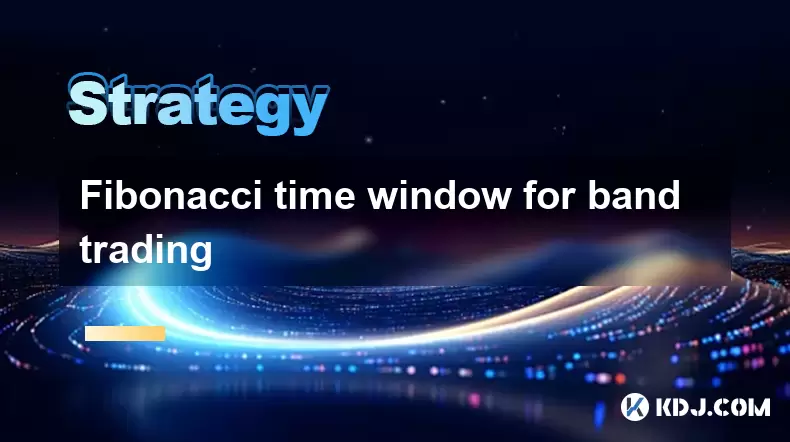-
 bitcoin
bitcoin $123963.239194 USD
1.37% -
 ethereum
ethereum $4529.082464 USD
1.07% -
 xrp
xrp $2.983640 USD
0.71% -
 tether
tether $1.000287 USD
0.02% -
 bnb
bnb $1179.874393 USD
2.99% -
 solana
solana $230.633678 USD
1.55% -
 usd-coin
usd-coin $0.999835 USD
0.03% -
 dogecoin
dogecoin $0.254240 USD
1.34% -
 tron
tron $0.341176 USD
0.15% -
 cardano
cardano $0.842285 USD
0.52% -
 hyperliquid
hyperliquid $48.537896 USD
-0.86% -
 chainlink
chainlink $21.863092 USD
-0.84% -
 ethena-usde
ethena-usde $0.999743 USD
-0.07% -
 sui
sui $3.579561 USD
-0.18% -
 stellar
stellar $0.403418 USD
2.67%
Fibonacci time window for band trading
Fibonacci time windows enhance band trading by predicting reversal points, helping traders set precise entry and exit points based on key time intervals.
Jun 01, 2025 at 02:42 pm

Understanding Fibonacci Time Windows in Band Trading
Band trading is a popular strategy within the cryptocurrency trading community that involves setting upper and lower price bands to guide buy and sell decisions. Integrating Fibonacci time windows into this strategy can enhance the precision of these trades. Fibonacci time windows are based on the Fibonacci sequence, a series of numbers where each number is the sum of the two preceding ones. In trading, these windows help predict potential reversal points in time rather than price.
The application of Fibonacci time windows in band trading revolves around identifying key moments when the price is likely to reverse or continue its trend. Traders use these time windows to set up their trades around these predicted intervals, aiming to capitalize on the expected market movements. Understanding how to correctly apply Fibonacci time windows can significantly improve the effectiveness of band trading strategies.
Calculating Fibonacci Time Windows
To apply Fibonacci time windows in band trading, traders first need to identify significant highs and lows on their price charts. These points serve as the starting point for the Fibonacci time projection. Here's how to calculate these time windows:
- Identify a significant low or high point on the chart. This will be your starting point.
- Count the number of periods (days, hours, etc.) until the next significant high or low.
- Apply the Fibonacci sequence to this period. Common Fibonacci ratios used for time windows include 1, 2, 3, 5, 8, 13, 21, 34, 55, and 89.
- Project these periods forward from the starting point to find potential time windows where reversals might occur.
For example, if the period between a significant low and the next high is 10 days, the Fibonacci time windows would be projected at 10, 20, 30, 50, 80, 130, 210, 340, 550, and 890 days from the starting low.
Integrating Fibonacci Time Windows with Band Trading
Band trading typically involves setting upper and lower bands around a moving average. When combined with Fibonacci time windows, traders can refine their entry and exit points. Here's how to integrate these two strategies:
- Set up your bands around a moving average of your choice. Common choices include the 20-day or 50-day moving average.
- Identify key Fibonacci time windows as described above.
- Monitor price action as it approaches these time windows. If the price is nearing an upper or lower band around a Fibonacci time window, it may signal a potential reversal.
- Adjust your trading strategy based on these signals. For instance, if the price is nearing the upper band and a Fibonacci time window, consider selling or shorting. Conversely, if it's nearing the lower band and a Fibonacci time window, consider buying.
Practical Example of Fibonacci Time Windows in Band Trading
To illustrate how this strategy works, let's consider a hypothetical scenario involving Bitcoin (BTC). Suppose you're monitoring BTC's price over a period and have identified a significant low on January 1st and a subsequent high on January 10th. The period between these points is 10 days.
- Calculate Fibonacci time windows: From January 1st, the Fibonacci time windows would be January 11th, January 21st, January 31st, February 20th, March 21st, May 11th, July 20th, October 18th, January 16th of the following year, and April 15th of the following year.
- Set up your bands: You decide to use a 20-day moving average with upper and lower bands set at two standard deviations.
- Monitor price action: As the price approaches the upper band around January 21st (a Fibonacci time window), you notice the price is struggling to break through the band. This could signal a potential reversal.
- Execute your trade: Based on this signal, you decide to sell or short BTC, anticipating a price drop.
Adjusting Strategies Based on Fibonacci Time Windows
Fibonacci time windows are not infallible, and their effectiveness can vary based on market conditions. Therefore, it's crucial to adjust your trading strategy accordingly. Here are some tips for fine-tuning your approach:
- Combine with other indicators: Use Fibonacci time windows in conjunction with other technical indicators like RSI, MACD, or Bollinger Bands to confirm signals.
- Backtest your strategy: Before applying it in live markets, backtest your Fibonacci time window strategy to see how it would have performed historically.
- Stay flexible: Be prepared to adjust your time windows and trading bands based on current market volatility and trends.
Managing Risks with Fibonacci Time Windows
While Fibonacci time windows can enhance band trading, they also come with risks. It's essential to manage these risks effectively to protect your capital. Here are some risk management strategies:
- Use stop-loss orders: Always set stop-loss orders to limit potential losses if the market moves against your position.
- Diversify your trades: Don't rely solely on Fibonacci time windows. Diversify your trading strategies to spread risk.
- Monitor market conditions: Keep an eye on broader market trends and news that could affect cryptocurrency prices, as these can impact the effectiveness of Fibonacci time windows.
Frequently Asked Questions
Q1: Can Fibonacci time windows be used for all cryptocurrencies?A1: Yes, Fibonacci time windows can be applied to any cryptocurrency. However, their effectiveness may vary depending on the liquidity and volatility of the specific cryptocurrency.
Q2: How often should I recalculate Fibonacci time windows?A2: It's advisable to recalculate Fibonacci time windows whenever there's a new significant high or low in the price chart. This ensures that your projections remain relevant to current market conditions.
Q3: Are there any software tools that can help with calculating Fibonacci time windows?A3: Yes, many trading platforms and software tools, such as TradingView and MetaTrader, offer features to calculate and project Fibonacci time windows, making it easier for traders to apply this strategy.
Q4: Can Fibonacci time windows be used in conjunction with other time-based analysis techniques?A4: Absolutely, Fibonacci time windows can be combined with other time-based analysis techniques like Gann angles or cycle analysis to enhance the accuracy of your trading signals.
Disclaimer:info@kdj.com
The information provided is not trading advice. kdj.com does not assume any responsibility for any investments made based on the information provided in this article. Cryptocurrencies are highly volatile and it is highly recommended that you invest with caution after thorough research!
If you believe that the content used on this website infringes your copyright, please contact us immediately (info@kdj.com) and we will delete it promptly.
- BlockDAG, DOGE, HYPE Sponsorship: Crypto Trends Shaping 2025
- 2025-10-01 00:25:13
- Deutsche Börse and Circle: A StableCoin Adoption Powerhouse in Europe
- 2025-10-01 00:25:13
- BlockDAG's Presale Buzz: Is It the Crypto to Watch in October 2025?
- 2025-10-01 00:30:13
- Bitcoin, Crypto, and IQ: When Genius Meets Digital Gold?
- 2025-10-01 00:30:13
- Stablecoins, American Innovation, and Wallet Tokens: The Next Frontier
- 2025-10-01 00:35:12
- NBU, Coins, and Crypto in Ukraine: A New Yorker's Take
- 2025-10-01 00:45:14
Related knowledge

Practical parameter settings for a Bitcoin multi-timeframe moving average system
Sep 18,2025 at 10:54pm
Optimizing Timeframe Combinations for Bitcoin Trading1. Selecting appropriate timeframes is crucial when building a multi-timeframe moving average sys...

How can I filter out false breakouts in Dogecoin high-frequency trading?
Sep 22,2025 at 01:00am
Understanding False Breakouts in Dogecoin Trading1. A false breakout occurs when Dogecoin's price appears to move beyond a defined support or resistan...

Techniques for identifying tops and bottoms in the Bitcoin on-chain NVT model
Sep 20,2025 at 07:54pm
Understanding the NVT Model in Bitcoin Analysis1. The Network Value to Transactions (NVT) ratio is often described as the 'P/E ratio' of the cryptocur...

What does the surge in open interest in Bitcoincoin futures mean?
Sep 20,2025 at 11:18pm
Understanding the Surge in Dogecoin Futures Open Interest1. A surge in open interest within Dogecoin futures indicates a growing number of active cont...

How can I use the Ethereum USDT premium to gauge market sentiment?
Sep 18,2025 at 11:55pm
Understanding the Ethereum USDT Premium1. The Ethereum USDT premium refers to the price difference between USDT (Tether) traded on Ethereum-based plat...

What should I do if Ethereum staking yields decline?
Sep 20,2025 at 06:18am
Understanding the Causes Behind Declining Ethereum Staking Yields1. The Ethereum network transitioned to a proof-of-stake consensus mechanism with the...

Practical parameter settings for a Bitcoin multi-timeframe moving average system
Sep 18,2025 at 10:54pm
Optimizing Timeframe Combinations for Bitcoin Trading1. Selecting appropriate timeframes is crucial when building a multi-timeframe moving average sys...

How can I filter out false breakouts in Dogecoin high-frequency trading?
Sep 22,2025 at 01:00am
Understanding False Breakouts in Dogecoin Trading1. A false breakout occurs when Dogecoin's price appears to move beyond a defined support or resistan...

Techniques for identifying tops and bottoms in the Bitcoin on-chain NVT model
Sep 20,2025 at 07:54pm
Understanding the NVT Model in Bitcoin Analysis1. The Network Value to Transactions (NVT) ratio is often described as the 'P/E ratio' of the cryptocur...

What does the surge in open interest in Bitcoincoin futures mean?
Sep 20,2025 at 11:18pm
Understanding the Surge in Dogecoin Futures Open Interest1. A surge in open interest within Dogecoin futures indicates a growing number of active cont...

How can I use the Ethereum USDT premium to gauge market sentiment?
Sep 18,2025 at 11:55pm
Understanding the Ethereum USDT Premium1. The Ethereum USDT premium refers to the price difference between USDT (Tether) traded on Ethereum-based plat...

What should I do if Ethereum staking yields decline?
Sep 20,2025 at 06:18am
Understanding the Causes Behind Declining Ethereum Staking Yields1. The Ethereum network transitioned to a proof-of-stake consensus mechanism with the...
See all articles










































































